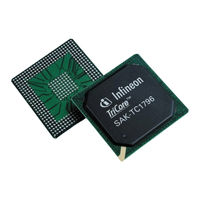
User Manuals: Infineon Technologies TC1796 TriCore
Manuals and User Guides for Infineon Technologies TC1796 TriCore. We have 1 Infineon Technologies TC1796 TriCore manual available for free PDF download: User Manual
Infineon Technologies TC1796 User Manual (2150 pages)
32-Bit Single-Chip Microcontroller
Brand: Infineon Technologies
|
Category: Controller
|
Size: 14 MB
Table of Contents
-
-
Features49
-
-
CPU Diagram100
-
Execution Unit102
-
Reset System104
-
Interrupt System105
-
Trap System105
-
PMI Features121
-
PMI Registers123
-
DMI Features128
-
DMI Registers131
-
-
Overview150
-
PLL Parameters161
-
Lock Detection168
-
Overview178
-
-
-
Power-On Reset199
-
Reset Operations199
-
Software Reset200
-
Booting Scheme204
-
Addressing208
-
Boot ROM208
-
-
Power Management224
-
Idle Mode227
-
Sleep Mode228
-
Input Channel232
-
Output Channel234
-
FPU Interrupts257
-
Flash Interrupt258
-
-
-
Overview295
-
Atomic Transfers296
-
Block Transfers296
-
Single Transfers296
-
Basic Operation298
-
LFI Register309
-
Overview312
-
Clock Management320
-
Address Triggers321
-
Grant Triggers322
-
OCDS Registers335
-
Boot ROM352
-
-
-
Read Mode362
-
Command Mode363
-
Page Mode364
-
Write369
-
Power Supply389
-
Shut-Down Mode389
-
Sleep Mode389
-
Reset Control390
-
Flash Registers391
-
-
Sbram414
-
Sram414
-
Internal Overlay419
-
Region Priority419
-
Data Read Buffer420
-
DMU Registers422
-
9 Memory Maps
431 -
-
Port 0 Registers474
-
Port 1478
-
Port 1 Registers482
-
Port 2484
-
Port 2 Registers489
-
Port 3492
-
Port 3 Registers497
-
Port 4499
-
Port 4 Registers503
-
Port 5506
-
Port 5 Registers509
-
Port 7517
-
Port 7 Registers520
-
Port 8522
-
Port 8 Register525
-
Port 9527
-
Port 9 Register530
-
-
PCP Architecture539
-
PCP Processor540
-
PCP Code Memory541
-
Register R0544
-
Register R6545
-
Register R7546
-
Context Models548
-
Channel Programs562
-
PCP Operation565
-
Normal Exit566
-
Debug Exit568
-
Channel Watchdog576
-
Invalid Opcode576
-
DMA Primitives577
-
Load and Store578
-
Bit Manipulation581
-
Flow Control581
-
Addressing Modes582
-
Bit Addressing583
-
PRAM Addressing583
-
PCP Registers589
-
CHKB, Check Bit620
-
CLR, Clear Bit620
-
INB, Insert Bit625
-
LD, Load628
-
NEG, Negate633
-
NOT, Logical NOT633
-
OR, Logical or634
-
PRI, Prioritize635
-
RL, Rotate Left637
-
RR, Rotate Right637
-
SET, Set Bit638
-
SHL, Shift Left638
-
SHR, Shift Right639
-
ST, Store640
-
XCH, Exchange642
-
Channel Resume650
-
COPY Instruction653
-
PCP Memories662
-
-
Features667
-
DMA Principles669
-
Error Conditions679
-
Circular Buffer683
-
Bus Switch685
-
Interrupts691
-
System Registers709
-
Registers775
-
-
Block Diagram780
-
EBU Power Supply784
-
Wait Input, WAIT784
-
Disabled798
-
Emulation Mode798
-
Boot Process799
-
Data Read Buffer817
-
Burst Phase (BP)824
-
Signal List828
-
Signal List843
-
BFCLKO Output849
-
EBU Registers857
-
-
-
Overview890
-
Enable Bit (SRE)894
-
NMI Enable916
-
Operation918
-
Overview918
-
-
15 System Timer
918 -
-
Disable Mode946
-
Normal Mode946
-
Time-Out Mode946
-
Prewarning Mode947
-
Time-Out Period956
-
Normal Period958
-
-
Overview973
-
OCDS Level 1976
-
Basic Concept977
-
Debug Actions979
-
BCU OCDS Level 1981
-
DMA OCDS Level 1981
-
RW Mode984
-
JTAG Interface987
-
Advertisement
Advertisement
Related Products
- Infineon Technologies TC1784
- Infineon Technologies TC1728
- Infineon Technologies TriBoard TC2X3
- Infineon Technologies TriCore Compiler
- Infineon Technologies TLE9879QX
- Infineon Technologies TLE987x EvalBoard
- Infineon Technologies TLE9869QX
- Infineon Technologies TLE986x
- Infineon Technologies TLE9845
- Infineon Technologies TLE984*QX
